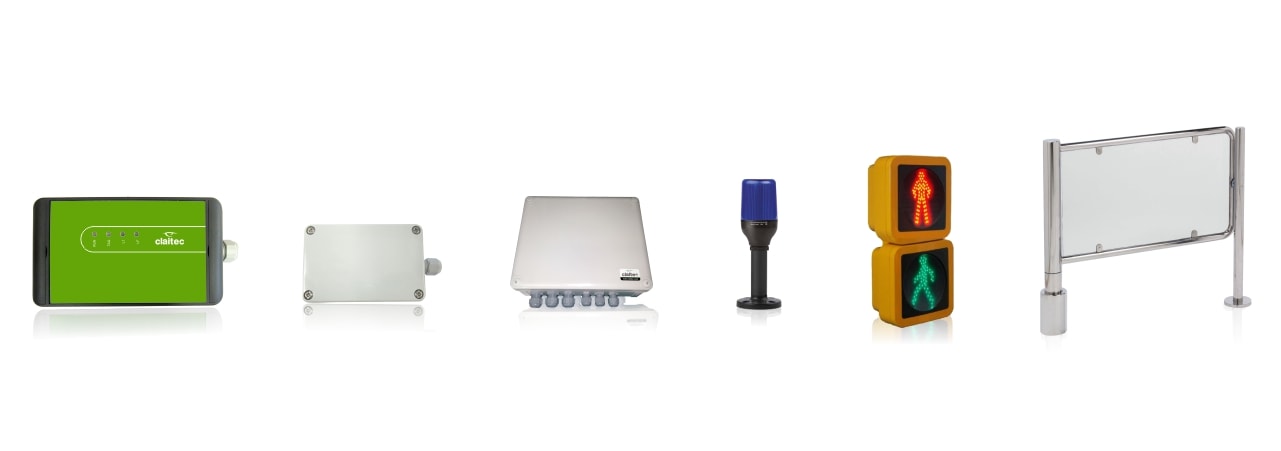Solution
The TCS (Traffic Control System) is a solution used to segregate pedestrians from forklifts in a joint work space.
What is it?
The TCS solution is designed to prevent accidents between people and cargo vehicles. Forklift circulating around the workspace automatically activate the warning and signalling elements previously installed at different points in this space. The system provides an automated control in the spaces shared by operators and forklifts.
How does it work?
The forklifts incorporate a PAS system with an AC-50 activator that generates a radio frequency field around it.
Similarly, TZ2-Tag devices are installed in different points of the workspace to detect previously equipped vehicles.
When a forklift enters the safety zone defined by the TZ2-Tag, the vehicle and warehouse lighting warnings are activated, alerting those in the vicinity of the presence of the vehicle.
At the same time, the system automatically turns the pedestrian traffic light red and blocks the safety gate to prevent any pedestrians from crossing. Only when the vehicle leaves the safety space, the traffic light will turn green and the gates will open.
Similarly, TZ2-Tag devices are installed in different points of the workspace to detect previously equipped vehicles.
When a forklift enters the safety zone defined by the TZ2-Tag, the vehicle and warehouse lighting warnings are activated, alerting those in the vicinity of the presence of the vehicle.
At the same time, the system automatically turns the pedestrian traffic light red and blocks the safety gate to prevent any pedestrians from crossing. Only when the vehicle leaves the safety space, the traffic light will turn green and the gates will open.
What elements does it include?
This is a very easy-to-install, durable system that only requires an RFID activator, a TZ2-Tag, a control box and its beacons, as well as the gates and traffic lights that the workspace may require.
Where can it be used?
The Traffic Control System is ideal to be used in work areas with little or no visibility, in spaces with a lot of forklift and operator traffic, and sites with pedestrian-forklift crossings.
For example, it is frequently installed in factory spaces, warehouses, loading docks, production lines and other industrial sites.
For example, it is frequently installed in factory spaces, warehouses, loading docks, production lines and other industrial sites.
Advantages
· This system is especially outstanding for its effectiveness and ability to solve problems. In spaces where accident at work rates are high, the TCS Solution provides security and it eradicates human error in relation to such important matters as accident prevention alerts and actions.
· The automation of the signals and pedestrian/forklifts segregation mechanisms becomes of great assistance and its results are very easily verifiable.
· You can install as many tags in parallel as necessary. This allows you to expand the alert zone and configure it according to the interests of each client and the needs of each work space.
· The automation of the signals and pedestrian/forklifts segregation mechanisms becomes of great assistance and its results are very easily verifiable.
· You can install as many tags in parallel as necessary. This allows you to expand the alert zone and configure it according to the interests of each client and the needs of each work space.
Things to consider:
When the System is used to detect personal tags, it’s effective up to maximum distances of about 6 - 6.5 meters (from where the antennas are installed) from the frontal and posterior areas, and about 4 meters from the sides.
In addition, there’s also a complementary functionality for this system. It has to do with the fact that, up until now, all the operating possibilities mentioned started from a unidirectional use of the TZ2Tag. However, the bidirectional model indicates to the forklift that it had just read a fixed Tag. This activates a signal on the vehicle, which can limit its speed, for example. In other words, when the forklift reads a wall Tag located within the zone that is detecting it, the forklift’s speed is automatically limited.
In addition, there’s also a complementary functionality for this system. It has to do with the fact that, up until now, all the operating possibilities mentioned started from a unidirectional use of the TZ2Tag. However, the bidirectional model indicates to the forklift that it had just read a fixed Tag. This activates a signal on the vehicle, which can limit its speed, for example. In other words, when the forklift reads a wall Tag located within the zone that is detecting it, the forklift’s speed is automatically limited.

